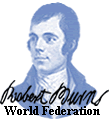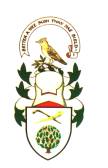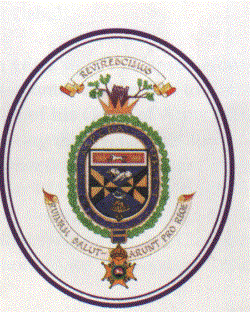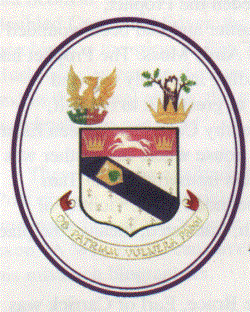


 |
 |
 |
 |
The
Myth And By
Samuel K. Gaw |
 |
|||||
|
More than 200 years have passed since the death of the national poet of Scotland, Robert Burns, to whom these events were to dominate his outlook on life and his works. "At
Wallace', |
|||||||
|
|||||||
 |
|||||||
|
The
Campbell Connection -(Right) |
|||||||
 |
The Arms of JAMES BURNS |
||||||
|
(Left) - The Redesigned Arms The spurious Campbell connection deleted and the seal of Robert Burns accentuated |
|||||||
|
The
Arms of JAMES BURNS (Matriculated the 14th Day of April 1851) |
|||||||
|
THE INSTRUMENTS OF THE FARMER AND COUNTRY MAN What about the other details. The Motto "Wood?notes Wild", a quotation from Milton's "L'Allegro", surmounting a whistling laverock perching on a bay?leaf sprig. Surely very suitable, a favourite Bird and, himself, a songster. The Motto on the base, "Better a wee bush than nae beild". A truism still quoted in Ayrshire, and in the barren Ayrshire of Burns' boyhood shelter from even a small bush would be useful. Burns never explained his fixation with Holly and the Holly Bush, although Ayrshire and the Carrick Bailiwick abounds with references. His mother's great grandfather was an adherent of Peden the Prophet, soldier?covenanter and had been wounded at their defeat at Airds Moss. The Prophet had escaped by hiding in a holly tree and subsequently, at great risk to himself, preached at nearby Culzean. Culzean Estate contained the house where his mother was born. Characters immortalised in Tam O Shanter, abounded in the vicinity of Culzean which, translated, means "the place of the holly". Robert the Bruce, Earl of Carrick was born and lived near the birthplace of the Poet's mother. On the Coat of Arms of Robert the Bruce are holly bedecked supporters. In "The Vision" Coila, the muse herself wearing a crown of holly honoured Scotland's Bard with her own garland. "But
wear you this The prickles on holly are confined to the lower branches but his insistence on this plant are unexplained, especially as he emphasises that it must be a small bush, not a tree.
Burns
ordered the seal in 1794, but was not to receive the completed seal or
seals until 1796, just two short months before he died. Sadly, his emphasised
wishes were ignored ? the Stock and Horn appeared almost classical in
design. The Club was certainly a Crook modelled like any one to be found
at a Game Fair, the Bush was certainly tree?like. Should Burns have made one mistake it is his insistence that the Motto "Better a Wee Bush" should be "at the bottom of the shield in the usual place". The usual place for the motto in Scottish Heraldry is above the Crest. English Heraldry has it usually below |
|||||||
|
The Campbell Legend Lawful Armourial Bearings were never registered by Burns yet his design was incorporated officially into the Arms of relatives, and these were to spawn a strange legend, completely erroneous, oft repeated. In 1837 the Burns Crest was first incorporated into the Arms of James Burnes, Town Councillor, and grandson of the Poet's cousin. It was to this cousin that Burns sent along the song "The Bed of Sweet Roses" and told of the excesses of a religious order "The Buchanites" in Irvine. The cousins were the grandsons of James Burnes of Brawlinmuir in Kincardineshire. James, whose Arms were registered, was a Fellow of the Royal College of Physicians in Edinburgh, and Physician General to the East India Company. His Armourial Bearings incorporate the device of Robert Burns. In 1837 these Bearings contained the directive that the design should be "...
a Holly bush surmounted by It further asserted that he was descended from Walter Campbell of Burnhouse, who fled to Buchan during the 17th Century Civil Wars. Losing the name of Campbell, the Burnhouse was corrupted into Burness and then Burns, allegedly for reasons of security. On
the crest is a Lion Couchant, pierced by a spear, lying on a shield of
Clan Campbell. A tree stump pretentiously shows life returning as proof
that the family is reviving their "previous greatness". It will
be seen from this that the Poet could have been kinder to the Scottish
nobility for it was at Loudoun Castle, the home of the Earl of Stair,
a Campbell, that the Treaty of Union was drawn up, and of which Burns
said "cost Scotland even its very name" The legend is still repeated even today, without the speaker questioning why a Campbell should require, in a staunch Presbyterian area, to change his name, and why a Gaelic name should be translated before usage. And why, more conveniently, do they ignore the fact that the name Burness was common in the Mearns by the early 17th century. The career of the aforementioned, James Burness, took off. He was head of the Medical Department of the Army in Bombay. Unfortunately in the Indian Mutiny his two brothers, they being also in the service of the East India Company, were massacred at Kabul.
"...
from a recent investigation, |
|||||||
|
The well-known Crest of Robert Burns, has, therefore, appeared twice officially included in the Arms recorded by James Burnes, the Grandson of Burns' cousin and yet it was never officially recorded by the Poet. The Lyon Clerk wrote to the users of the Crest, the Burns Federation, and advised on the illegality. Thanks to Lyon and Lyon Court the design as stated by the Poet was given to the Federated Burns Clubs.
Burns, annoyed by the insidious English elements creeping into Scots life and Heraldry since the Union, would approve of the Scots elements: the simple helm of an old Scottish Warrior Knight, the Mantling doubled Green and Silver, the Laverock perching on the sprig of Bay Tree, the Holly Bush, all elements in their natural colours, and in the Escrol above, the motto "Better a wee bush than nae bield". These were the egalitarian symbols the Poet craved. They prove his complete understanding of the "Gentle Art" but not even "A Wee Bush" can save the Poet from his mistaken biographers This article, contributed by Sam Gaw, was previously published in 1996 in the magazine "Scottish Highlights" |
|||||||
| © 2008 The Robert Burns World Federation | |||||||